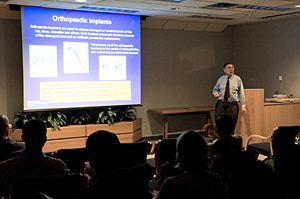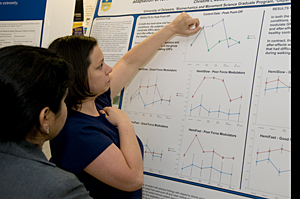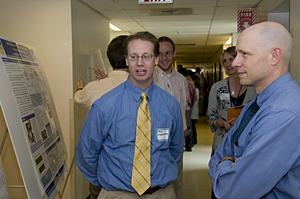
- Rozovsky wins prestigious NSF Early Career Award
- UD students meet alumni, experience 'closing bell' at NYSE
- Newark Police seek assistance in identifying suspects in robbery
- Rivlin says bipartisan budget action, stronger budget rules key to reversing debt
- Stink bugs shouldn't pose problem until late summer
- Gao to honor Placido Domingo in Washington performance
- Adopt-A-Highway project keeps Lewes road clean
- WVUD's Radiothon fundraiser runs April 1-10
- W.D. Snodgrass Symposium to honor Pulitzer winner
- New guide helps cancer patients manage symptoms
- UD in the News, March 25, 2011
- For the Record, March 25, 2011
- Public opinion expert discusses world views of U.S. in Global Agenda series
- Congressional delegation, dean laud Center for Community Research and Service program
- Center for Political Communication sets symposium on politics, entertainment
- Students work to raise funds, awareness of domestic violence
- Equestrian team wins regional championship in Western riding
- Markell, Harker stress importance of agriculture to Delaware's economy
- Carol A. Ammon MBA Case Competition winners announced
- Prof presents blood-clotting studies at Gordon Research Conference
- Sexual Assault Awareness Month events, programs announced
- Stay connected with Sea Grant, CEOE e-newsletter
- A message to UD regarding the tragedy in Japan
- More News >>
- March 31-May 14: REP stages Neil Simon's 'The Good Doctor'
- April 2: Newark plans annual 'wine and dine'
- April 5: Expert perspective on U.S. health care
- April 5: Comedian Ace Guillen to visit Scrounge
- April 6, May 4: School of Nursing sponsors research lecture series
- April 6-May 4: Confucius Institute presents Chinese Film Series on Wednesdays
- April 6: IPCC's Pachauri to discuss sustainable development in DENIN Dialogue Series
- April 7: 'WVUDstock' radiothon concert announced
- April 8: English Language Institute presents 'Arts in Translation'
- April 9: Green and Healthy Living Expo planned at The Bob
- April 9: Center for Political Communication to host Onion editor
- April 10: Alumni Easter Egg-stravaganza planned
- April 11: CDS session to focus on visual assistive technologies
- April 12: T.J. Stiles to speak at UDLA annual dinner
- April 15, 16: Annual UD push lawnmower tune-up scheduled
- April 15, 16: Master Players series presents iMusic 4, China Magpie
- April 15, 16: Delaware Symphony, UD chorus to perform Mahler work
- April 18: Former NFL Coach Bill Cowher featured in UD Speaks
- April 21-24: Sesame Street Live brings Elmo and friends to The Bob
- April 30: Save the date for Ag Day 2011 at UD
- April 30: Symposium to consider 'Frontiers at the Chemistry-Biology Interface'
- April 30-May 1: Relay for Life set at Delaware Field House
- May 4: Delaware Membrane Protein Symposium announced
- May 5: Northwestern University's Leon Keer to deliver Kerr lecture
- May 7: Women's volleyball team to host second annual Spring Fling
- Through May 3: SPPA announces speakers for 10th annual lecture series
- Through May 4: Global Agenda sees U.S. through others' eyes; World Bank president to speak
- Through May 4: 'Research on Race, Ethnicity, Culture' topic of series
- Through May 9: Black American Studies announces lecture series
- Through May 11: 'Challenges in Jewish Culture' lecture series announced
- Through May 11: Area Studies research featured in speaker series
- Through June 5: 'Andy Warhol: Behind the Camera' on view in Old College Gallery
- Through July 15: 'Bodyscapes' on view at Mechanical Hall Gallery
- More What's Happening >>
- UD calendar >>
- Middle States evaluation team on campus April 5
- Phipps named HR Liaison of the Quarter
- Senior wins iPad for participating in assessment study
- April 19: Procurement Services schedules information sessions
- UD Bookstore announces spring break hours
- HealthyU Wellness Program encourages employees to 'Step into Spring'
- April 8-29: Faculty roundtable series considers student engagement
- GRE is changing; learn more at April 15 info session
- April 30: UD Evening with Blue Rocks set for employees
- Morris Library to be open 24/7 during final exams
- More Campus FYI >>
2:37 p.m., May 18, 2009----The Center for Biomedical Engineering Research (CBER) at the University of Delaware held its annual biomechanics research symposium on May 15. The event, attended by more than 70 faculty and students, featured student presentations, a poster session, and a keynote address by Irving M. Shapiro, professor at Thomas Jefferson University.
CBER is an interdisciplinary center focused on providing engineering science and clinical technology to reduce the impact of disease on the everyday life of individuals. Directed by Jill Higginson, assistant professor of mechanical engineering, CBER includes more than 35 faculty members from four departments at UD as well as researchers from other institutions.
Shapiro's talk, “Molecular Engineering of Orthopedic Implants: From Bench to Bedside,” described the collaborative development of a smart implant that may provide a solution to a problem that affects 2-5 percent of patients who undergo joint replacement surgery -- periprosthetic infection.
The infection results in revision surgeries that are more expensive, more painful, and less successful than primary implant surgeries. “The cost of this problem is astronomical,” Shapiro said. “It's currently estimated at half a billion dollars per year, which may be conservative, and it's rising.”
The smart implant is based on the use of a unique chemical system that covalently tethers an antibiotic to inert substances such as the titanium rods used in prosthetic knees, hips, shoulders, and elbows. It has been tested successfully in injured racehorses at the University of Pennsylvania School of Veterinary Medicine, and studies are underway to evaluate its efficacy in humans.
“So I guess the title of my talk is not completely accurate,” Shapiro quipped. “We haven't made it to the bedside yet, but we have reached the stable-side.”
Shapiro's lecture was followed by podium presentations of graduate student research, with awards given to the best presenters. Judges included Shapiro; Kurt Manal, assistant professor of mechanical engineering; Darcy Reisman, assistant professor of physical therapy; and Steven Stanhope, interim dean of the College of Health Sciences and professor of health, nutrition and exercise sciences.
Winners were postdoctoral researcher Christopher Price, for his paper “Direct Measurement of Loading-Enhanced Solute Transport Within the Lacunar-Cannicular System of Bone,” and graduate student Mehmet Uygur, for “Kinematics and Kinetics of Misstep Conditions: Implications for Femoral Fractures in the Elderly.”
An afternoon poster session featured more than 40 posters on a broad range of biomechanics topics. Poster session winners were postdoc Li-Wei Chou (“Motor Unit Discharge Behavior in Patients with Stroke”) and graduate student Christopher Henderson (“Articular Cartilage Contact Area Changes with Increasing Knee Flexion in Subjects with Moderate Knee Osteoarthritis: Appearance of Two Subgroups”).
All four winners received travel vouchers for use in presenting their work at national conferences.
“The symposium provides our students with a great opportunity to share their research, giving them valuable experience and laying the foundation for future collaborations with others in the UD biomechanics community,” Higginson says.
“We were very pleased to have Dr. Shapiro as our keynote speaker,” she continued. “He was able to engage the diverse audience and inspire us to seek creative and multidisciplinary solutions to the tough problems being addressed in the field of biomedical engineering.”
Shapiro, professor of orthopedic surgery, biochemistry, and molecular biology at Jefferson, serves on the external advisory committee for UD's COBRE (Centers of Biomedical Research Excellence) grant, which is funded by the National Institutes of Health.
Article by Diane Kukich
Photos by Doug Baker




